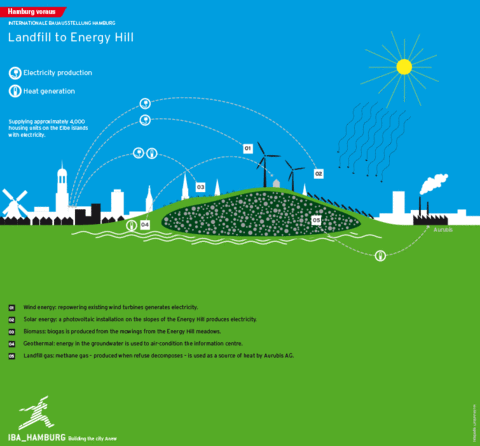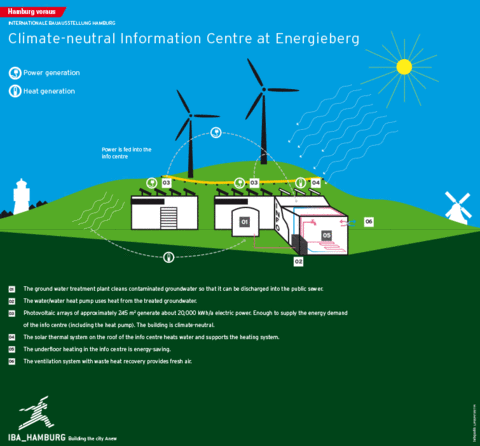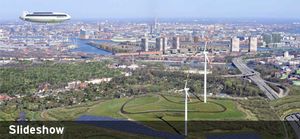Georgswerder Energy Hill
From toxic waste dump to prime example of renewable energy generation: the Georgswerder landfill site has been transformed into a renewable energy hill as part of the Internationale Bauausstellung IBA Hamburg (International Building Exhibition). It supplies around 4000 households with electricity using wind power and solar energy alone, and is being made accessible to the public as a view point.
The grass-covered hill, around 40 metres high and visible from afar, has a turbulent history. After World War II the flat grasslands in north-eastern Wilhelmsburg were piled up with rubble and domestic waste, later followed by toxic industrial waste including lacquer and paint. In 1979 the landfill was officially closed down, but in 1983 it became clear that highly toxic dioxins were escaping from the foot of the artificial hill and seeping into the groundwater. The landfill and the ground beneath it were made safe at great cost, in close collaboration with the Georgswerder Working Group and residents from the surrounding area. The site was then covered with a plastic sealing sheet and topsoil, before the first wind turbines were erected. The groundwater is protected by extensive technical measures to this day.
New Forms of Energy
The first wind turbines were erected on the summit of the landfill site back in the 1990s. A new, larger wind turbine has now stood on the hill since early December 2011. The south-facing slope is home to a large photovoltaic unit. The first phase of construction was carried out in 2009 by HAMBURG ENERGIE and resulted in approximately 500 kWp (kilowatts peak), while the second phase followed in December 2011, and increased the performance by around another 200 kWp.The inside of the hill is also a source of energy: continuous decomposition processes produce landfill gas with a high level of methane. For many years this has been systematically collected and supplied to the nearby company Aurubis AG, one of Europe’s largest copper smelters. The seepage water from the landfill and the groundwater are also collected, purified in a controlled process, and drained. A heat pump allows the energy content of the groundwater to be used to generate space heating for the new operations building and information centre.
The Energy Hill Welcomes the City
The landfill site was off limits to the public for decades; a high fence surrounds the 45 hectare area. Since 2013 the mound has been made accessible, and can be visited by Hamburg residents. As a hill, it offers a fantastic view over Hamburg. In 2011 the “Energy Hill” was made accessible on guided tours as part of the IBA Hamburg, and an area the size of the Binnenalster Lake can now be visited as an educational space with a viewpoint. The history of the landfill, the treatment of contaminated waste, and the diverse potential for obtaining renewable forms of energy are explained and brought to life in a vivid way.The hill is considered to be a technical structure and will remain a closed and secured landfill site. For this reason it is only accessible during opening hours.
Information Centre
In 2012 the information centre opened at the foot of the hill, featuring a multimedia show called “The Tamed Dragon”. This exhibition presents the many different facets of the site. It focuses on the history of Georgswerder, the landfill, and the way in which it was made safe, as well as providing information on the IBA Hamburg, the “Georgswerder Energy Hill” project, and the potential of renewable forms of energy.The information centre adjoins the existing groundwater treatment plant, where visitors can observe the technology used for making the landfill safe.
The building's energy concept is based on the use of renewable forms of energy and maximising energy savings; the purified groundwater from the landfill is used as one of the sources of heat.
Competition
In 2013 the exhibition “Georgswerder Energy Hill – The Third Act!” was launched in the outdoor area. In conjunction with the State Ministry for Urban Development and Environment Hamburg, the IBA Hamburg 2009 announced a Europe-wide competition for the design of the “Energy Hill”. The primary idea by the winner of the first prize (HÄFNER/JIMÉNEZ Büro für Landschaftsarchitektur and Konermann Siegmund Architekten) was a man-made “horizon footpath” encircling the summit of the hill. This offers sweeping views on all sides, while also making a pleasant place for visitors to linger. At night a mysterious white ring glows on the “Energy Hill” and can be seen from a distance, making it a landmark that is visible all over Hamburg, and a new symbol of Wilhelmsburg.
Meeting Place Energy Hill
The "Georgswerder Energy Hill" became with about 60.000 visitors in 2013 a meeting place for Wilhelmsburg residents and visitors from elsewhere, as it offers a spectacular view from the Harbour to the St Michaelis Church. Furthermore, it is being used for several events such as the skater contests, the Skyline-Run or Tango and Yoga workshops. The Hill will also broaden local horizons by providing short educational tours to demonstrate the transformation of a toxic, contaminated site into a showcase for the generation of renewable energy.
What Hamburg once saw only as a “rubbish heap” now promises to become a popular open space and a new destination for day trips. Almost half of the project costs for the new building and landscaping work (€ 4.25 million out of € 9.57 million) came from the ERDF (EuropeanRegional Development Fund).
- 2010: installation of the photovoltaic unit
- December 2011: installation of the new wind turbine
- June 2012: opening of the exhibition featuring the multimedia show “The Tamed Dragon”
- March 2013: opening of the “horizon footpath”
This project is supported by:
European Union
European Regional Development Fund
Investing in Your Future

ADDRESS
SPECIFICATIONS
Size:
45 ha – of which 22 ha will be open to the public (an area equivalent in size to the Binnenalster Lake)
Height:
Around 40 metres
Components:
Photovoltaic solar system
1st construction phase with 500 kWp: 2009
2nd construction phase with 200 kWp: 2011
New wind turbine with 3 400 kWp: 2011
Existing wind turbine 1 500 kWp
Overall performance:
Electricity for 4.000 households (12.200.000 kWh /a)



